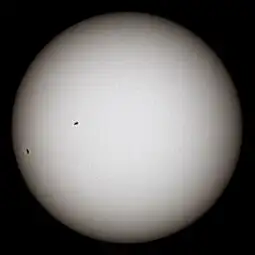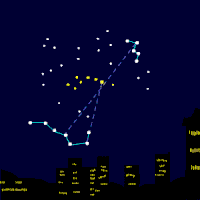Portal:Stars
IntroductionA star is an astronomical object comprising a luminous spheroid of plasma held together by self-gravity. The nearest star to Earth is the Sun. Many other stars are visible to the naked eye at night; their immense distances from Earth make them appear as fixed points of light. The most prominent stars have been categorised into constellations and asterisms, and many of the brightest stars have proper names. Astronomers have assembled star catalogues that identify the known stars and provide standardized stellar designations. The observable universe contains an estimated 1022 to 1024 stars. Only about 4,000 of these stars are visible to the naked eye—all within the Milky Way galaxy. A star's life begins with the gravitational collapse of a gaseous nebula of material largely comprising hydrogen, helium, and trace heavier elements. Its total mass mainly determines its evolution and eventual fate. A star shines for most of its active life due to the thermonuclear fusion of hydrogen into helium in its core. This process releases energy that traverses the star's interior and radiates into outer space. At the end of a star's lifetime, its core becomes a stellar remnant: a white dwarf, a neutron star, or—if it is sufficiently massive—a black hole. Stellar nucleosynthesis in stars or their remnants creates almost all naturally occurring chemical elements heavier than lithium. Stellar mass loss or supernova explosions return chemically enriched material to the interstellar medium. These elements are then recycled into new stars. Astronomers can determine stellar properties—including mass, age, metallicity (chemical composition), variability, distance, and motion through space—by carrying out observations of a star's apparent brightness, spectrum, and changes in its position in the sky over time. Stars can form orbital systems with other astronomical objects, as in planetary systems and star systems with two or more stars. When two such stars orbit closely, their gravitational interaction can significantly impact their evolution. Stars can form part of a much larger gravitationally bound structure, such as a star cluster or a galaxy. (Full article...) Selected star - Four images of Sun Photo credit: NASA's STEREO
The Sun is the star at the center of the Solar System. The Sun has a diameter of about 1,392,000 kilometers (865,000 mi) (about 109 Earths), and by itself accounts for about 99.86% of the Solar System's mass; the remainder consists of the planets (including Earth), asteroids, meteoroids, comets, and dust in orbit. About three-quarters of the Sun's mass consists of hydrogen, while most of the rest is helium. Less than 2% consists of other elements, including iron, oxygen, carbon, neon, and others. The Sun's color is white, although from the surface of the Earth it may appear yellow because of atmospheric scattering. Its stellar classification, based on spectral class, is G2V, and is informally designated a yellow star, because the majority of its radiation is in the yellow-green portion of the visible spectrum. In this spectral class label, G2 indicates its surface temperature of approximately 5,778 K (5,505 °C), and V (Roman five) indicates that the Sun, like most stars, is a main sequence star, and thus generates its energy by nuclear fusion of hydrogen nuclei into helium. Selected article -Photo credit: NASA
In astronomy, stellar classification is a classification of stars based on their spectral characteristics. The spectral class of a star is a designated class of a star describing the ionization of its chromosphere, what atomic excitations are most prominent in the light, giving an objective measure of the temperature in this chromosphere. Light from the star is analyzed by splitting it up by a diffraction grating, subdividing the incoming photons into a spectrum exhibiting a rainbow of colors interspersed by absorption lines, each line indicating a certain ion of a certain chemical element. The presence of a certain chemical element in such an absorption spectrum primarily indicates that the temperature conditions are suitable for a certain excitation of this element. If the star temperature has been determined by a majority of absorption lines, unusual absences or strengths of lines for a certain element may indicate an unusual chemical composition of the chromosphere. Most stars are currently classified using the letters O, B, A, F, G, K, and M (usually memorized by astrophysicists as "Oh, be a fine girl/guy, kiss me"), where O stars are the hottest and the letter sequence indicates successively cooler stars up to the coolest M class. According to informal tradition, O stars are called "blue", B "blue-white", A stars "white", F stars "yellow-white", G stars "yellow", K stars "orange", and M stars "red", even though the actual star colors perceived by an observer may deviate from these colors depending on visual conditions and individual stars observed. The current non-alphabetical scheme developed from an earlier scheme using all letters from A to O; the original letters were retained but the star classes were re-ordered in the current temperature order when the connection between the stars' class and temperatures became clear. A few star classes were dropped as duplicates of others. Selected image -.jpg.webp) NGC 7293, a planetary nebula Photo credit: Hubble Space Telescope/NASA and ESA
A planetary nebula is an emission nebula consisting of an expanding glowing shell of ionized gas and plasma ejected during the asymptotic giant branch phase of certain types of stars late in their life. This name originated with their first discovery in the 18th century because of their similarity in appearance to giant planets when viewed through small optical telescopes, and is otherwise unrelated to the planets of the solar system. They are a relatively short-lived phenomenon, lasting a few tens of thousands of years, compared to a typical stellar lifetime of several billion years. Planetary nebulae play a crucial role in the chemical evolution of the galaxy, returning material to the interstellar medium that has been enriched in heavy elements and other products of nucleosynthesis. Did you know?
SubcategoriesTo display all subcategories click on the ►
Stars Stars by luminosity class Stars by metallicity Stars by spectral type Stars by type Stars with proper names Lists of stars Star types Astronomical catalogues of stars Star atlases Coats of arms with stars Star symbols Stars in the Andromeda Galaxy Star clusters Fiction about stars Stellar groupings Hypothetical stars Star images Sun Star systems Wikipedia categories named after stars Star stubs Sun Atmospheric radiation Solar calendars Coats of arms with sunrays Coats of arms with suns Sun in culture Day Horizontal coordinate system Missions to the Sun Solar observatories Solar phenomena Solar alignment Solar eclipses Solar energy Sun tanning Sundials Sun stubs Galaxies Astronomical catalogues of galaxies Galaxies discovered by year Fiction about galaxies Galaxy clusters Galaxy filaments Galaxy superclusters Lists of galaxies Galaxy morphological types Active galaxies Barred galaxies Dark galaxies Dwarf galaxies Elliptical galaxies Field galaxies Hypothetical galaxies Galaxy images Interacting galaxies Irregular galaxies Lenticular galaxies Low surface brightness galaxies Overlapping galaxies Peculiar galaxies Polar-ring galaxies Protogalaxies Ring galaxies Seyfert galaxies Spiral galaxies Starburst galaxies Supermassive black holes Galaxy stubs Wikipedia categories named after galaxies Black holes Fiction about black holes Intermediate-mass black holes Stellar black holes Supermassive black holes White holes Supernovae Fiction about supernovae Historical supernovae Hypernovae Discoverers of supernovae Supernova remnants Selected biography - Galileo Galilei's portrait painted in 1636 Photo credit: By Justus Sustermans
Galileo Galilei (Italian pronunciation: [galiˈlɛo galiˈlɛi]; 15 February 1564 – 8 January 1642) was an Italian physicist, mathematician, astronomer, and philosopher who played a major role in the Scientific Revolution. His achievements include improvements to the telescope and consequent astronomical observations, and support for Copernicanism. Galileo has been called the "father of modern observational astronomy", the "father of modern physics", the "father of science", and "the father of modern science". Stephen Hawking says: "Galileo, perhaps more than any other single person, was responsible for the birth of modern science." The motion of uniformly accelerated objects, taught in nearly all high school and introductory college physics courses, was studied by Galileo as the subject of kinematics. His contributions to observational astronomy include the telescopic confirmation of the phases of Venus, the discovery of the four largest satellites of Jupiter (named the Galilean moons in his honour), and the observation and analysis of sunspots. Galileo also worked in applied science and technology, inventing an improved military compass and other instruments. Galileo's championing of Copernicanism was controversial within his lifetime, when a large majority of philosophers and astronomers still subscribed (at least outwardly) to the geocentric view that the Earth is at the centre of the universe. After 1610, when he began publicly supporting the heliocentric view, which placed the Sun at the centre of the universe, he met with bitter opposition from some philosophers and clerics, and two of the latter eventually denounced him to the Roman Inquisition early in 1615. In February 1616, although he had been cleared of any offence, the Catholic Church nevertheless condemned heliocentrism as "false and contrary to Scripture", and Galileo was warned to abandon his support for it—which he promised to do. When he later defended his views in his most famous work, Dialogue Concerning the Two Chief World Systems, published in 1632, he was tried by the Inquisition, found "vehemently suspect of heresy", forced to recant, and spent the rest of his life under house arrest. TopicsWikiProjects
More science WikiProjects...
Things to do
Related portalsMore science portals...
Associated WikimediaThe following Wikimedia Foundation sister projects provide more on this subject:
Discover Wikipedia using portals
|




